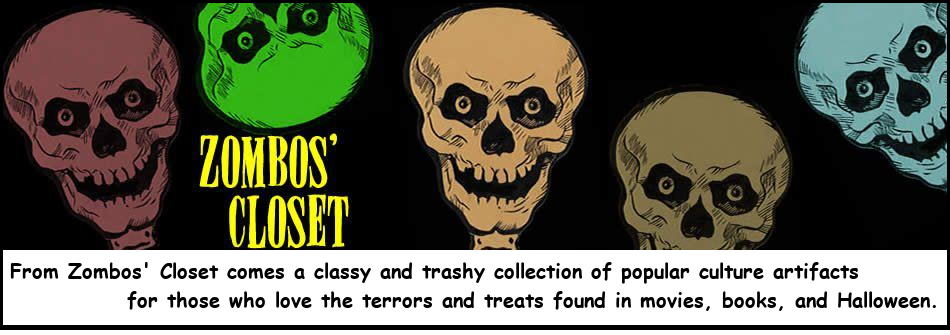Zombos Says: Good
“Stop me if you’ve heard this one, but there’s this movie with an abandoned farm house in the middle of a cornfield and–” I started to say. I was preparing Zombos’ tax information, and my library desk was littered with receipts, scraps of paper notations, vexing forms, and two bone china cups of cold coffee. I decided to take a break.
“–You mean Dead Birds?” interrupted Zombos without looking up from his New York Times newspaper.
“What? No! The cornfield has this smelly, burlap sack-for-a-head decrepit scarecrow–”
“Dark Night of the Scarecrow, then? He turned a page.
“No! If you let me finish, it’s a more recent movie. There are these five college people–well, really they’re too old to play college kids unless they just love to hang out there, but for the sake of the movie you’ve got to go with it–traveling down a country road in an SUV and–”
“Oh, Hallowed Ground, then.”
“No way. Their SUV crashes when a flock of crows bury their beaks deep into the windshield and bleed their guts all over the car.”
“Kakashi, that Japanese horror movie?”
“Definitely not.”
“Scarecrows?”
“Fun movie to watch it’s so bad, but no! Can I finish? All right, then. The movie’s Husk.”
“Oh, one of those After Dark entries.” Zombos turned another page.
“Why aren’t you using the iPad Zimba bought you for Christmas? It’s got the Times on it,” I asked, changing the subject.
Zombos ignored me. Some old people can’t seem to shake the habit of smearing black newsprint ink on their fingertips and crushing pulp paper into awkward folds, I suppose.
“Anyway, getting back to Husk, it’s one of those good After Dark movie entries,” I said. “I mean, if it weren’t for the careless day-for-night lighting used in every supposedly dark scene, I’d even go as far as saying it’s very good.”
Zombos continued to read his newspaper, but he did it with much less crinkling noise and his lips had stopped moving, so I knew he was listening. I continued.
“The crash knocks them all out, but when they wake up, the jock (Wes Chatham) and the nerd (Devon Graye) go looking for help and their missing friend (Ben Easter) , while the cool guy (C. J. Thomason)–it’s his SUV that got slammed by the birds–stays by the car and waits. We don’t know much about their missing friend, but the jock’s girlfriend (Tammin Sursok) stays behind, too. She and the cool guy don’t get along. One of those, she’s-getting-all-the-attention-now kind of sticky buddy-buddy situations, you know?”
“I am not sure I would,” said Zombos. “What is a five letter word for ‘corny’ and ‘artificial’?
“Hokey,” I answered. “Leave the Jumble alone for a minute and listen. And there’s no hokey in Husk, by the way, but a few good twists around familiar characters; the nerd doesn’t die first and he actually figures things out; the girl isn’t kept as a screaming foil; the jock actually acts fairly smart and doesn’t wuse out when the terror starts; and cool guy turns out to be not so cool.
“Natalie, the jock’s girlfriend, gets antsy waiting, so she goes for a walk and finds a scarecrow lying on the ground.”
“It does not sound overly taxing in the terror department so far,” said Zombos.
“The scarecrow, when she pulls the burlap sack back, has teeth. That’s pretty much when things perk up. The mystery involves the upstairs room with the foot-pedal sewing machine, dead people walking and sacking up, and flashbacks the nerd, Scott, experiences. Those flashbacks involve the former tenants of the farm house and what happened to them.
“Action kicks in when they try to leave through the cornfield; they can’t; turmoil erupts when the jock won’t leave without his girlfriend, but it’s a moot point, though I won’t spoil it for you by explaining why; and there’s a frantic escape attempt by the formerly cool guy now acting like girly man, which leaves much blood on the ground but a clue as to the limitations of the scarecrow creeps.
“Director and writer Brett Simons, with the help of his actors and production design team, whip up a nifty ghost slash scarecrow monster slash terror-in-the-corn story with a backstory that adds familial, country-gothic depth to the mayhem. The only stretching of credulity comes into play when everyone gets so battered, you wonder how they can keep going with all their blood leaking out like that.”
“So what do the scarecrows do to bloody them up, throw corn husks at them?” asked Zombos, dryly.
“Don’t be silly, of course not. The scarecrows pound long metal nails into each of their fingers, giving them quite a terminal grip.”
Zombos put his newspaper down. “Perhaps we should do a marathon viewing of scarecrow-related horror movies. What do you think? It has been a while since we last saw something in the cinematorium.”
I looked at the pile of papers waiting on my desk and thought about it. I jumped up after a brief moment of reflection. “Definitely! We can start with Husk and go backwards. I’ll have Chef Machiavelli bring the coffee cart. This will be an all-nighter for sure.”















